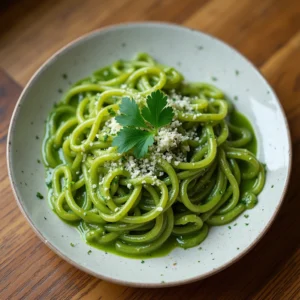When you think of pasta, Italy might come to mind first, but culinary magic often happens when traditions meet creativity. Green spaghetti, or espagueti verde, is a vibrant Mexican twist on the classic Italian staple. This dish blends creamy poblano pepper sauce, fresh cilantro, and pasta into an explosion of color and flavor. Whether you’re a pasta aficionado or someone seeking a new dish to impress family and friends, green spaghetti is worth exploring. In this article, we’ll uncover its origins, delve into its preparation, highlight variations, and explain why it’s more than just another pasta dish.
Discovering Green Spaghetti: A Fusion of Flavors
Green spaghetti is more than just a meal; it’s an edible journey into the heart of Mexican culture with a surprising Italian twist. Imagine the comforting softness of spaghetti paired with a silky, herbaceous sauce that’s as bold as it is beautiful. This dish owes its signature green hue to poblano peppers and cilantro, both beloved staples in Mexican cuisine. Combined with creamy ingredients, it results in a rich sauce that envelops every strand of pasta.
But why is it called a fusion? Simply put, it’s a meeting of Mexican flavors and Italian techniques. The use of pasta reflects Italy’s influence, while the green sauce is undeniably rooted in Mexico’s culinary heritage. The dish exemplifies how two distinct food cultures can unite harmoniously, producing something entirely unique.
What makes green spaghetti truly remarkable is its adaptability. While the traditional recipe is undoubtedly a star, the dish lends itself to endless customization. You can make it spicy, tone it down for milder palates, or even tweak it for dietary preferences. This flexibility ensures that it remains a favorite across households, making it a dish worth passing down through generations.
The Mexican Roots of Espagueti Verde
Green spaghetti, or espagueti verde, beautifully illustrates the blending of culinary traditions that often happens when cultures meet. Its roots trace back to Mexican kitchens, where locally cherished ingredients like poblano peppers and cilantro took center stage. However, the dish also carries the subtle influence of Italian immigrants who introduced pasta to Mexico. As a result, a unique creation emerged—one that marries the soft textures of spaghetti with the bold, creamy flavors of Mexican sauces.
Unlike traditional Italian pasta, which often leans on tomato or olive oil-based sauces, espagueti verde bursts with the smoky and herbaceous charm of roasted poblano peppers. These peppers, combined with Mexican crema (a tangy sour cream) and cheese, create the velvety green sauce that defines the dish. What makes this fusion particularly fascinating is how it remains distinctly Mexican, from its choice of ingredients to the bold flavors that reflect the country’s rich culinary heritage.
Traditional Occasions for Serving Green Spaghetti
In Mexican households, espagueti verde isn’t just another weeknight meal—it’s a dish tied to celebration and togetherness. Whether it’s a holiday feast, a birthday gathering, or a Sunday family reunion, green spaghetti frequently graces the table as a vibrant, comforting side. It often complements grilled meats like chicken or beef, creating a balanced plate that pleases diverse palates.
The dish’s visual appeal also makes it a showstopper at events. Its striking green color and creamy consistency draw attention, while its adaptability ensures everyone can enjoy it. From mild versions suited for children to spicier renditions for adventurous eaters, espagueti verde has become a staple of festive Mexican cuisine.
Key Components of Green Spaghetti
Crafting the perfect green spaghetti starts with choosing the right ingredients. While the list is simple, each component plays an essential role in shaping the dish’s flavor, texture, and appearance. At its core are poblano peppers, which provide a smoky foundation. These are complemented by the tangy richness of Mexican crema and cheese, which bind the sauce into a smooth, luscious texture. Meanwhile, fresh cilantro adds a bright herbal note that makes the dish pop both visually and in taste. Of course, let’s not forget the spaghetti itself, which acts as the vessel for this delightful sauce.
Poblano Peppers: The Heart of the Sauce
If there’s one ingredient that defines espagueti verde, it’s poblano peppers. Known for their mild heat and earthy flavor, these peppers lend the dish its characteristic depth and smokiness. The magic begins with roasting, a process that intensifies the pepper’s natural flavors and gives the sauce its signature complexity. Once roasted, the peppers are peeled to remove their tough skin, ensuring a silky smooth texture when blended.
Despite their bold taste, poblanos aren’t overwhelmingly spicy, making them an ideal choice for families. They add just the right amount of heat to keep things interesting without overpowering the dish. Their versatility also allows for creative adaptations—blend them with a little garlic or onion for an even richer profile.
The Creamy Elements: Crema and Cheese
What sets espagueti verde apart is its velvety, creamy sauce, and the secret lies in the combination of Mexican crema and cheese. Crema, a staple in Mexican kitchens, provides a tangy, slightly sweet flavor that balances the smokiness of the poblano peppers. It’s lighter than heavy cream, which helps keep the sauce rich but not overly heavy.
Cheese, often queso fresco or cream cheese, plays a dual role in the sauce. It adds thickness, helping the sauce cling perfectly to the spaghetti, and imparts a subtle saltiness that enhances the overall flavor. The interplay of these creamy elements transforms green spaghetti from a simple pasta dish into a luxurious experience.
Enhancing Flavors with Fresh Cilantro
No espagueti verde is complete without cilantro. This humble herb does more than just add color; it brings a burst of freshness that brightens the entire dish. Its slightly citrusy, herbal notes cut through the richness of the creamy sauce, providing balance and harmony. Cilantro also pairs beautifully with poblano peppers, creating a symphony of flavors that feels quintessentially Mexican.
For those who aren’t fans of cilantro’s bold flavor, parsley or fresh basil can serve as substitutes, though they’ll alter the dish’s traditional profile. However, when used sparingly and blended into the sauce, cilantro’s contribution is undeniable—it’s the final touch that makes green spaghetti unforgettable.
Nutritional Advantages of Green Spaghetti
When it comes to meals that strike the perfect balance between indulgence and nutrition, green spaghetti is hard to beat. It’s a dish that pleases your palate while nourishing your body. At the heart of its health benefits are poblano peppers, which are packed with vitamins A and C, essential for boosting immunity and promoting good vision. Cilantro, another key ingredient, is a powerhouse of antioxidants that help combat oxidative stress, supporting overall wellness.
For those looking to make their meals even more wholesome, using whole wheat pasta is an excellent choice. It’s rich in dietary fiber, which aids digestion and promotes a feeling of fullness, making green spaghetti as satisfying as it is tasty. Whether you enjoy it as a side dish or a main course, this vibrant pasta brings nutrition and comfort together in every bite.
Vitamins and Minerals in Poblano Peppers
Poblano peppers are more than just a flavor-packed ingredient—they’re a nutrient treasure trove. Rich in vitamin C, these peppers play a key role in maintaining a strong immune system, helping your body fight off illnesses. They also provide vitamin A, which is crucial for maintaining healthy skin, eyes, and mucous membranes.
In addition to vitamins, poblano peppers are a great source of potassium, a mineral that supports heart health and helps regulate blood pressure. The peppers also contain dietary fiber, which promotes digestive health and helps control blood sugar levels. For those seeking a nutrient-dense addition to their diet, poblano peppers in green spaghetti deliver health benefits without sacrificing taste.
Benefits of Whole Wheat Pasta Variations
For a healthier twist on traditional green spaghetti, swapping regular pasta for whole wheat varieties is a game-changer. Whole wheat pasta is higher in fiber, which aids in digestion and helps maintain stable blood sugar levels, making it an excellent option for those managing diabetes or looking to maintain a balanced diet.
Beyond fiber, whole wheat pasta provides a wealth of essential nutrients, including iron, magnesium, and B vitamins. These nutrients contribute to improved energy levels and support overall metabolic function. Additionally, the nuttier flavor of whole wheat pasta complements the creamy, smoky sauce of green spaghetti, enhancing the dish without overshadowing its signature taste.
Step-by-Step Guide to Making Green Spaghetti
Mastering green spaghetti at home is easier than you might think. The process involves three straightforward steps: roasting poblano peppers, blending the green sauce, and cooking the pasta. Each step adds layers of flavor and texture, ensuring a dish that’s as delightful to prepare as it is to eat.
Roasting and Peeling Poblano Peppers

Roasting poblano peppers is where the magic begins. This step intensifies their smoky flavor and makes the peppers easier to peel, ensuring a smooth sauce. Start by placing the peppers over an open flame or in a preheated oven under the broiler. Turn them occasionally until their skins are charred and blistered.
Once roasted, transfer the peppers to a sealed bag or cover them with a kitchen towel. This traps steam, loosening the skin for easy peeling. Remove the skin carefully, and don’t forget to discard the seeds and stems. This step is crucial for creating the creamy, velvety sauce that defines green spaghetti.
Blending the Perfect Green Sauce

With the peppers prepped, it’s time to create the star of the dish: the green sauce. In a blender, combine the roasted poblano peppers with Mexican crema, queso fresco or cream cheese, fresh cilantro, garlic, and a pinch of salt. Blend until the mixture achieves a smooth, luscious consistency.
The balance of ingredients is key here. Cilantro adds a fresh herbal note, while the crema and cheese bring creaminess and tang. If you want to adjust the sauce’s thickness, you can add a splash of milk or vegetable broth. The result is a vibrant, flavorful sauce that clings beautifully to the pasta.
Cooking and Combining the Pasta
Cooking the pasta is the final, yet equally important, step. Bring a pot of salted water to a rolling boil, and cook the spaghetti until it’s al dente. Drain the pasta, reserving a small amount of the cooking water to help blend the sauce and pasta later.
Return the drained pasta to the pot and pour the green sauce over it. Toss the pasta gently to ensure each strand is evenly coated with the sauce. If needed, add a splash of the reserved cooking water to adjust the sauce’s consistency. Serve immediately, garnished with extra cilantro or a sprinkle of cheese for a finishing touch.

Creative Twists on the Classic Recipe
One of the most delightful aspects of green spaghetti is its versatility. Whether you’re aiming to elevate its flavors or adapt it to dietary preferences, the possibilities are nearly endless. By experimenting with proteins, creating vegan variations, or pairing it with complementary side dishes, you can tailor this dish to suit any occasion or taste.
Adding Proteins: Chicken, Shrimp, and More
Adding protein to green spaghetti not only makes it heartier but also introduces a new dimension of flavor and texture. Grilled or pan-seared chicken breasts, seasoned with garlic and lime, are a classic pairing. The tender chicken absorbs the creamy green sauce, creating a well-balanced bite every time.
For seafood lovers, shrimp is an excellent option. Lightly sautéed shrimp, seasoned with chili powder and cumin, offers a delicious contrast to the richness of the sauce. Chorizo, with its bold and smoky flavors, is another fantastic choice, adding a spicy kick that complements the mild heat of the poblano peppers. These proteins not only enhance the dish but also make it versatile enough to serve as a satisfying main course.
Vegetarian and Vegan Adaptations
For those following a vegetarian or vegan lifestyle, green spaghetti can easily be adapted without losing its signature creamy flavor. Replace traditional crema with a plant-based sour cream or cashew cream for a similar tangy richness. Vegan cheeses, such as almond or soy-based cream cheese, work well as substitutes for queso fresco.
For extra protein, consider adding roasted chickpeas, sautéed mushrooms, or grilled tofu. These ingredients not only add texture but also complement the earthy flavors of the poblano peppers and cilantro. With these simple adjustments, green spaghetti becomes a wholesome, plant-based dish that everyone can enjoy.
Pairing Green Spaghetti with Side Dishes
The beauty of green spaghetti lies in how seamlessly it pairs with a variety of sides, enhancing its appeal as part of a complete meal. Garlic bread, with its buttery, garlicky crust, is a crowd-pleasing option that contrasts the creaminess of the pasta. Grilled vegetables, such as zucchini, bell peppers, and asparagus, provide a fresh and smoky complement to the richness of the sauce.
For a lighter option, a crisp salad featuring arugula, cherry tomatoes, and a lemon vinaigrette offers a refreshing balance to the dish’s creamy texture. These sides not only round out the meal but also highlight the versatility of green spaghetti, making it a perfect choice for casual dinners or festive gatherings.
FAQs about Green Spaghetti
1. What is green spaghetti made of?
Green spaghetti typically consists of pasta coated in a creamy green sauce made from poblano peppers, garlic, onions, cream, and cheese. Some variations include cilantro or spinach for added color and flavor.
2. What is Mexican spaghetti made of?
Mexican spaghetti combines pasta with a tomato-based sauce enriched with spices, garlic, onions, and sometimes cream or cheese. It often includes Mexican flavors like chipotle, cumin, or poblano peppers for a unique twist.
3. How do you make green spaghetti sensory?
To make green spaghetti sensory, focus on the texture and color. Use brightly colored green sauces (e.g., from blended spinach or poblano peppers), add soft or crunchy toppings like toasted nuts, and serve it with engaging garnishes like cilantro or lime for visual and sensory appeal.
4. Why is spaghetti squash green?
Spaghetti squash can be green if it is immature or not fully ripened. As it matures, it turns a yellow or orange color, indicating readiness for consumption. Green spaghetti squash is still edible but may have a firmer texture and less sweetness.
Embracing the Unique Taste of Green Spaghetti
Green spaghetti is far more than just another pasta dish—it’s a celebration of culinary creativity and cultural fusion. With its smoky poblano peppers, creamy texture, and vibrant green hue, this recipe combines the hearty comfort of Italian pasta with the bold, fresh flavors of Mexican cuisine.
What truly sets green spaghetti apart is its versatility. Whether served as a side dish at festive gatherings or customized with proteins and vegan alternatives, it adapts beautifully to suit any table or palate. Its simplicity in preparation, paired with its stunning presentation, makes it a recipe worth revisiting time and time again.
So why not bring this flavorful fusion into your kitchen? From its rich history to its endless possibilities, espagueti verde invites you to savor a dish that’s as delightful to make as it is to eat. It’s a culinary adventure you won’t want to miss!

